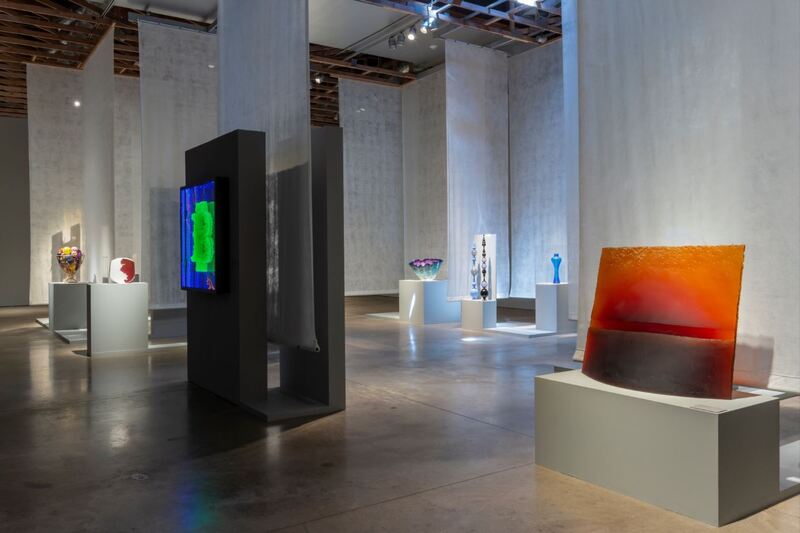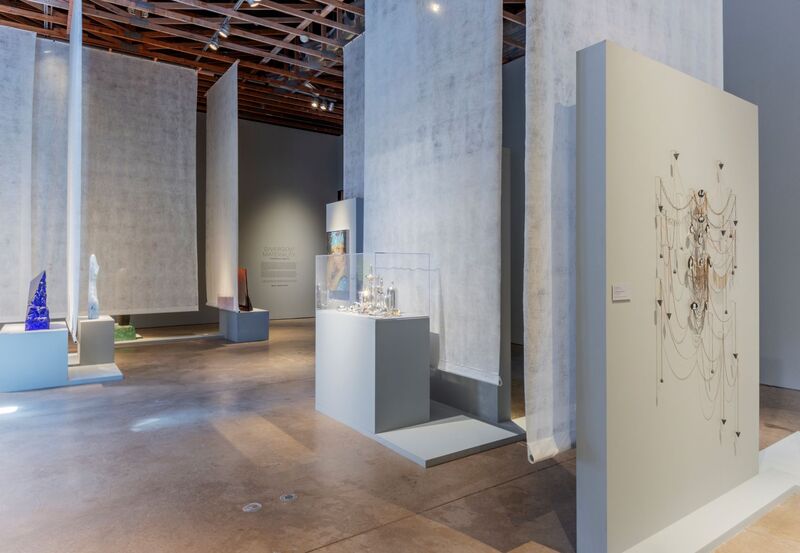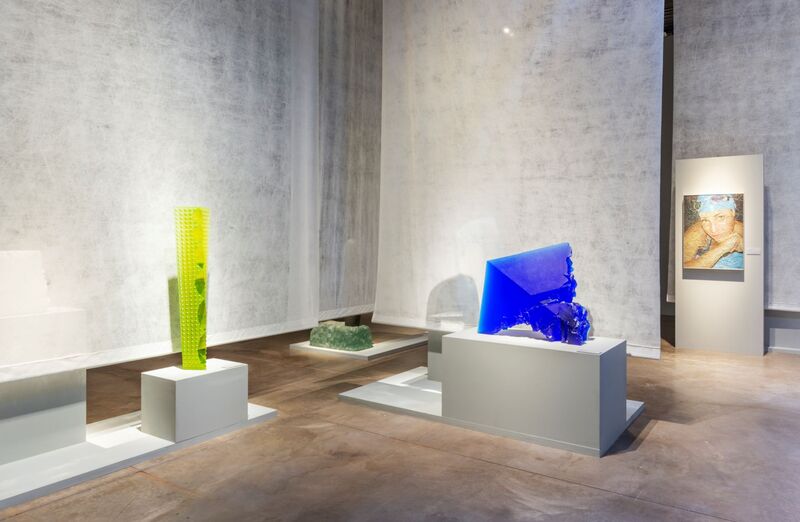|
Organized by Scottsdale Museum of Contemporary Art (SMoCA) and guest-curated by Lauren R. O'Connell.
Support provided by The Arizona Glass Alliance, Judy and Stuart Heller, Linda and Sherman Saperstein, Sharon and Fred Schomer, Penelope and Richard Post, Gail and Dan Tenn, and Lori and Michael Carmel. Installation design by Jay Atherton. |
The artistry of glass-making is over 4,000 years old, originating with the discovery of applying extreme heat to a mixture of silica sand—likely taken from the beaches along the coast of Mesopotamia and Egypt—and alkali, a naturally occurring chemical compound. This simple alchemy of heat and natural elements began an art form that has continuously evolved from the expulsion of glassmaking in Venice to the island of Murano at the beginning of the Renaissance, to the Studio Art movement started by two Americans in 1962. Over time the materiality of glass has been tested and transformed by artists. Today contemporary glass art is an expansive field that blends historical methods with current interests, resulting in stunning and divergent artworks.
Divergent Materiality: Contemporary Glass Art highlights contemporary glass artists—both masters and emerging—whose innovative approaches to using glass have advanced the medium’s discourse within contemporary art. The exhibition developed from a collaboration with four local glass art collector couples: Judy and Stuart Heller, Linda and Sherman Saperstein, Sharon and Fred Schomer, and Gail and Dan Tenn. Each couple brings a unique perspective to collecting and an abundance of knowledge about glass art and artists. The gallery installation features 30 selections from their collections and SMoCA’s collection. CASTING ABSTRACTION In direct opposition to the delicate nature of glass, the artworks in Casting Abstraction appear unapologetically solid and durable. Casting is the process of pouring molten glass into a mold. In these artworks, the artists chose to forgo representational qualities in favor of abstract forms. Through abstraction one can witness the artist’s interpretation of the world; such as the interaction between positive and negative space in Howard Ben Tré’s Paired Forms 3 (1993), the division of nature from the urban environment in Junichiro Baba’s Memory of Shadow (2000), the experience of nature in Peter Bremers’s Aquatic Space (2017), and the simplification of elements to heighten the appreciation of color, light, and form in Jan Exnar’s #10 Fluktus (2015) and Vladimira Klumpar’s Ricatan (2015). The minimal characteristics of the artworks also allow the viewer to focus on a single aspect, such as the vibrant colors of a sunset in Jaroslava Brychtová and Stanislav Libenský’s Horizon (1992). BLOWN FORMS Glass blowing is one of the most well-known glass-making techniques that originated from the Renaissance and continues to present day. Blown Forms highlights several artists who work to advance the art form that has been honed for hundreds of years. Venetian glass artist Lino Tagliapietra was born and trained on the island of Murano— famous for its glass artistry since 1291—and earned the rank of maestro in Venetian glass-blowing by the age of 25. His artwork and teaching influenced generations of glass artists in Italy, China, Japan, Australia, and the United States. In the gallery, adjacent to Tagliapietra’s Untitled (1980) is Blue Gum Tree (2010) by Dante Marioni who studied under Tagliapietra and Marioni’s father Paul Marioni at the Pilchuck Glass School in Stanwood, Washington. In 1962 on the East Coast, Harvey Littleton founded the Studio Glass Movement with the intention of bringing glass-making—traditionally done in a factory—into the artist studio where it could be used as a medium in fine artmaking. Littleton’s Blue Crossed Forms (1990) is an example of the complexity achieved through blowing glass. Along this same line, Dale Chihuly has become one of the most recognized names in glass art for his wildly colorful and complex sculptures. Chihuly’s Violet Macchia (1991) is one of the artist’s less ornate works, which allows the viewer to see the intricate pulling of colors. One of the youngest artists in the exhibition is Steven Ciezki. His Two Blue and Black Totems (2014) are glass towers shaped in response to urban architecture he drew inspiration from during his world travels. FIGURATIVE NARRATION The artists in Figurative Narration materialize stories through representations of the physical form, manipulating glass to express the complexities of the human condition. The translucent quality of glass can be used as a metaphor for the introspection of one’s own psyche, as Lucy Lyon does in Seeker (2014). Additionally, it can be a window to see through the tangible exterior of the human body, as Dean Allison has said about his work, like Waterbug (2016). The ability to express fluidity and density simultaneously makes glass an ideal material to consider the interplay of life and death, as seen in Bertil Vallien’s Destination Unknown (2018), where the figures are both suspended and submerged in a glass boat representing life’s flow towards death. Similarly, Christina Bothwell‘s ethereal sculptures of children and animals examine nature’s process of renewal by creating duplicates within the same work; whether it be multiples of a girl, as in Four Girls on a Bench (2018) or a figure imbedded within a larger body. Many of the artists address contemporary narratives of gentrification, homelessness, and the struggle for success; such as Oben Abright’s bust of a homeless man in Market Street Figure (2014) and Richard Jolley’s Running to Stay in Place (circa late-1990) that speaks to the working man’s struggle. The subject of identity in relation to the physical expression of one’s clothing is seen in Vivian Wang’s Rooster Princess (2014), which highlights the artist’s cultural heritage, and in Karen LaMonte’s Child’s Dress (2011) that provides a perception of the subject despite the absence of the body. BEYOND MATERIAL The artworks in Beyond Material present new perceptions of glass art, and use glass as a means to explore the boundaries of an idea. In Ginny Ruffner’s Patterns of Thought (1996), the glass spheres are intentionally made to represent visualizations of varying patterns of thought, with each ball simultaneously void of and open to all meaning. Matt Eskuche’s Artistocrap (2009) beautifully and ironically depicts glass as trash (empty water bottles and cigarette butts), while Flo Perkin’s Cone Kill (2000) humorously presents a “crushed” glass construction cone. Both works subvert the inherent qualities of fragility and preciousness in glass to bring forward ideas of consumption and waste. Ethan Stern casts layers of glass and cuts away at its white surface to create maps of coastlines, revealing a vibrant interior that mimics a bird’s eye view of a dystopic landscape in Red Structure Sound (2013). The concepts of social and economic networks have little connection to the materiality of glass, however Charlotte Potter’s The Weight of Lost Friendship (2014) is a matrix of precious cameo-style portraits of “unfriended” friends on Facebook. Rubén Fasani’s Dolar (2018) hints at the imbalance of value between the United States dollar and the Argentine peso, while Tim Tate’s Bitcoin/Wealth 21st Century (2018) explores the emergence of an entirely new currency—the virtual Bitcoin. Employing glass in these artworks seems to reference the precarious and fragile nature of such omnipresent networks, opening a conversation about the durability and longevity of the systems in which we rely. Cassandria Blackmore uses glass panels as a canvas for her reverse paintings. Once the painting is complete, the artist breaks the glass panel and reconstructs the pieces to create a fractured portrait in Midnight Dip (2000). The undetermined breaking path of the glass leads to the uncertain perception of material and subject. Rather than breaking, Therman Statom paints on and then builds with panels of glass. In Tore Del Sol (2017), Statom shapes a glass ladder, a common subject of his work, and adds smaller glass works to its surface. The trompe l’oeil of Joseph Ivacic’s Life is Beautiful (2016) creates an illusion of spray paint cans and steel beams covered in graffiti, however the entire work is made from blown and formed glass. Here the artist uses his glassmaking techniques to turn away from any traditional recognition of the material. In opposition, Ragna Róbertsdóttir’s installation Untitled (2007/2019) is made of shattered glass thrown onto the glue covered windows in the Museum’s lobby, highlighting the material’s brittleness and creating a beautifully dangerous mirage on the surface of the building. |




